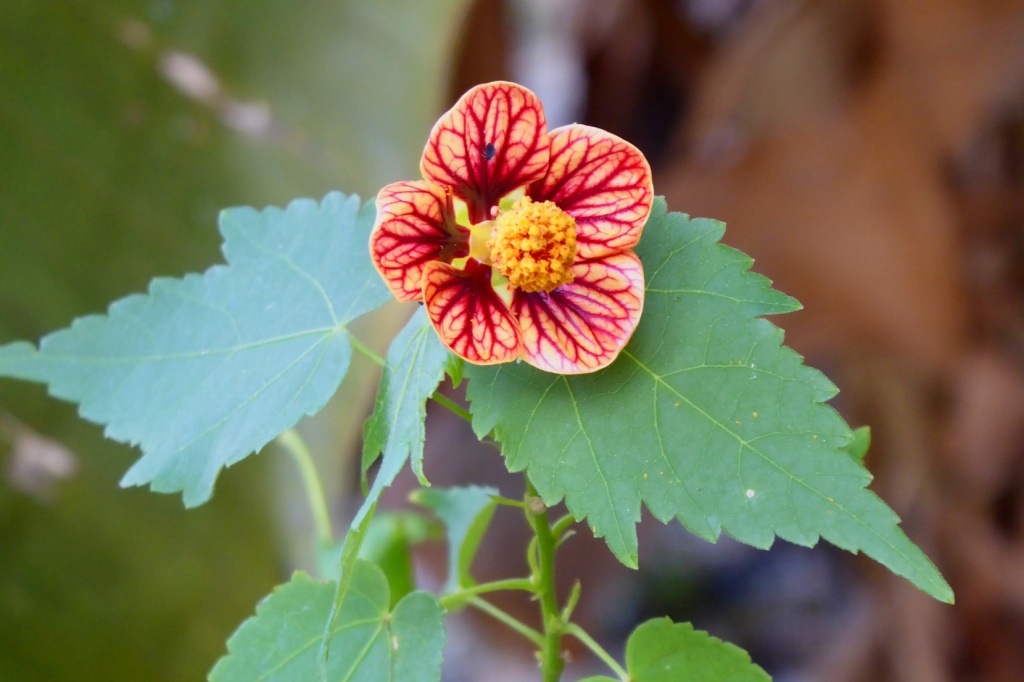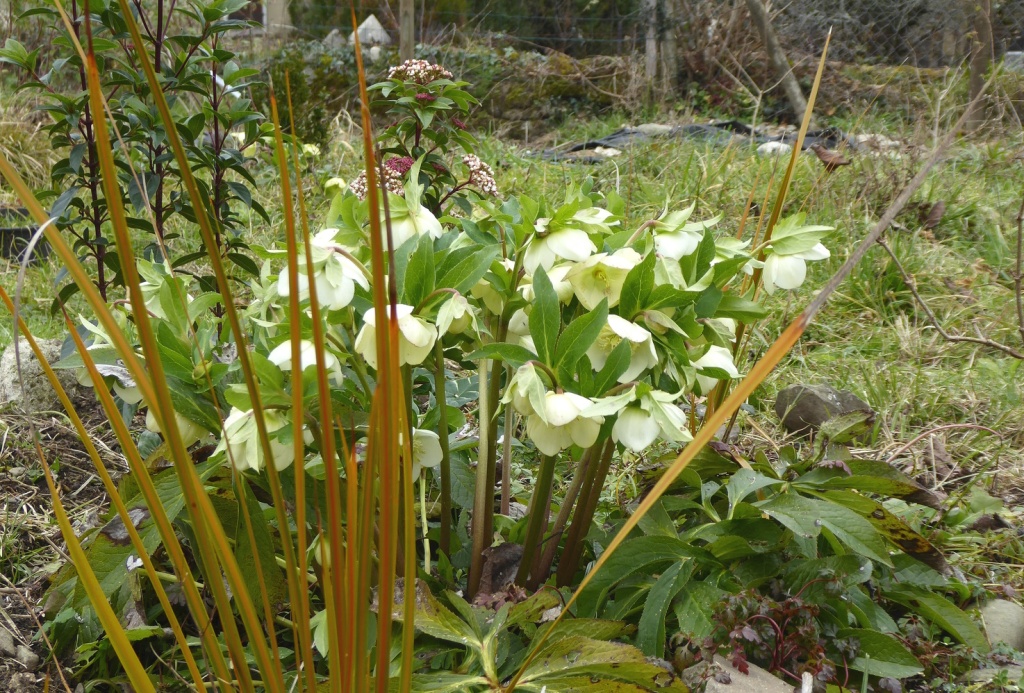
Well, this is the power of ‘One’. From underneath the fleece protecting it from the last 10 days of colder nights, there emerged just one brave little flower on the Abutilon pictum. Strangely, the cold conditions seem to have affected the colouring, a much stronger paprika orange than usual and darker red veining. It was a lso a bit of a midget, but I’m not complaining, it remains something of a miracle. I have always known this plant as Abutilon pictum, ‘Thompsonii’ being the variegated version.

Three years ago I bought three twiglet sized cuttings of this fabulous Libertia ixioides ‘Goldfinger’ to Oloron when we moved, and now, albeit slowly, they are gently beginning to run under the old cherry tree in the front garden. This is their season when the low sunlight brings the gold colouring to life. Such a good and obliging plant, it never disturbs another plant, it just sort of glides by, and the baby plants are easy to gently dig out and put them where you want them.
Well, this is the power of three or it will be, in the summer. Last year I potted up six small Kniphofia rooperi plants that I had grown from seed sown 3 years ago. I had hoped they might flower last summer, but no. Reading one or two blogs about Kniphofia, several writers suggested moving them, that the stimulus of being disturbed might egg them on to flower. So this morning, they were duly removed, split and replanted in the hummocky grass slope above the vines in the front garden. It’s stony, so I hoiked out (a good Scots word for ‘digging’) the big stones, leaving the little ones for drainage and planted them in threes, about 0.5 m apart from one another as I am going for a ‘clump’. We’ll see if this recipe will work…

Back in Tostat, I was a bit of a ‘one plant’ queen. Which is fine, but planting in threes or fours creates a companionable proximity for the plants and scientists now acknowledge that plants like to be together. Threes or fours means you’re heading towards a clump, which is exactly what my brain likes nowadays. Patterns, rhythms, connections and contrasts really work for me now, they didn’t so much when I was younger.

This is a contrast that I love, and whilst this photograph shows only one plant of my top favourite sculptural evergreens, Euonymus japonicus ‘Benkomasaki‘, this is one of a trio planted at the edge of the Agave americana zone. I have had this Euonymus for, mmm, maybe 7 years, and I absolutely love it. It is so tough and so verdant all year round, with tight, cuticled, glossy deep green leaves and it makes a great silhouette in the garden. I bought mine very small, maybe only 10cms high, and they are now maybe 75 cms, so they don’t grow fast, but because of that, to buy them at 75 cms is an expensive business. So I would recommend buying them small and being patient.
In the intervening years I have taken several cuttings too, which means that very slowly and surely, you will have more. They take months to root, so best to put them outside in a semi shady spot, water now and then and look at them a year later. There are new varieties, variously called ‘Green Spire’, ‘Green Tower’ and others, but I am not sure if it is the same plant with the same growth habit. It is a wonderful contrast with the glaucous blue-green of the Agave.

Jimi Blake of the famous Hunting Brook Gardens in Ireland raved about ‘El Rayo’ and that was enough for me to buy two plants. Many UK sites talk about rich soil conditions for Anisodontea- don’t do that! They really love poor, stony soil in full sun and need no extra watering at all. The downside of this preference is that they are shallow-rooted and so get a good bashing in our summer storms. But with a bit of spring pruning, they bounce back and are not that big that a 45 degree tilt is a massive problem. They flower like trains, sometimes having a few weeks off from flowering in hot summers, but even in the winter, they are dotted with these deep pink flowers.

This is the species plant, Anisodontea capensis, which is also really really good. It has smaller shell pink flowers but the same prodigious flowering almost all year round as ‘El Rayo’. I have two of each in the garrigue style garden in the front, and did I mention that cuttings take so quickly that you need never fear being without one.

I had tried another variety of Lomandra in Tostat, and really liked it for it’s spikey stubborness. But this plant has found the garrigue garden hard going, and so, even after nearly 3 years, it only looks good in the spring. So, it maybe I will give it another year, and if it hasn’t finally got going, it may be found a better home in the Barn Garden.

However, this robust little Mondo grass, Ophiopogon japonicus, is going to be a real ‘do-er’, I can tell. I bought 4 plants, and when they arrived, they were busting out of their pots. Sometimes at this time of year, nurseries sell plants that are desperate to be re-potted but haven’t been- so lucky me, I got 12 good sized chunks out of the 4 rumbunctiuous plants I received, and they are in the ground and looking great. This is the green version of the black Japanese grass that is often seen on gardening programmes. I will eat my hat if these don’t come good.

And here they are- in a group of four.




